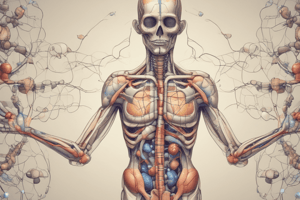Podcast
Questions and Answers
Activation of the μ receptor can lead to euphoria and pain relief.
Activation of the μ receptor can lead to euphoria and pain relief.
True (A)
Activation of the kappa receptor does not lead to sedation.
Activation of the kappa receptor does not lead to sedation.
False (B)
Both μ and kappa receptors can cause respiratory depression.
Both μ and kappa receptors can cause respiratory depression.
True (A)
The kappa receptor is primarily involved in causing loss of appetite.
The kappa receptor is primarily involved in causing loss of appetite.
Dependence can occur as a result of activating the μ receptor.
Dependence can occur as a result of activating the μ receptor.
In low doses, it acts as a competitive antagonist to morphine.
In low doses, it acts as a competitive antagonist to morphine.
Higher doses of the substance do not mimic the effects of morphine.
Higher doses of the substance do not mimic the effects of morphine.
The substance exhibits analgesic properties only at low doses.
The substance exhibits analgesic properties only at low doses.
It is considered a competitive antagonist at low doses.
It is considered a competitive antagonist at low doses.
Only high doses are effective in blocking morphine's actions.
Only high doses are effective in blocking morphine's actions.
A full antagonist is a pure competitive antagonist.
A full antagonist is a pure competitive antagonist.
Naloxone is an example of a partial agonist.
Naloxone is an example of a partial agonist.
Pentazocine acts as a mixed agonist-antagonist.
Pentazocine acts as a mixed agonist-antagonist.
A mixed agonist-antagonist has only an antagonistic effect.
A mixed agonist-antagonist has only an antagonistic effect.
Nalorphine is an example of a pure competitive antagonist.
Nalorphine is an example of a pure competitive antagonist.
The presence of a reflexive response indicates a lack of respiratory distress.
The presence of a reflexive response indicates a lack of respiratory distress.
The observation of pupil constriction is unrelated to the rabbit's medical status.
The observation of pupil constriction is unrelated to the rabbit's medical status.
Respiratory distress can be evaluated by monitoring the rabbit's breathing patterns.
Respiratory distress can be evaluated by monitoring the rabbit's breathing patterns.
The absence of twitching does not imply any medical issues in the rabbit.
The absence of twitching does not imply any medical issues in the rabbit.
Presence of a medical sign in a rabbit could involve multiple observations.
Presence of a medical sign in a rabbit could involve multiple observations.
The righting reflex is observed in the untreated rabbit after the administration of nalorphine.
The righting reflex is observed in the untreated rabbit after the administration of nalorphine.
Miosis refers to the constriction of the pupils.
Miosis refers to the constriction of the pupils.
Administering the same dose of nalorphine to two separate rabbits will yield identical respiratory rates.
Administering the same dose of nalorphine to two separate rabbits will yield identical respiratory rates.
Observing activity levels after drug administration can help determine its effects.
Observing activity levels after drug administration can help determine its effects.
Respiratory rate is an irrelevant measure when evaluating the effects of nalorphine.
Respiratory rate is an irrelevant measure when evaluating the effects of nalorphine.
Flashcards are hidden until you start studying
Study Notes
Mu Receptor (μ)
- Activation of this receptor can lead to pain relief, analgesia, and euphoria.
- Activation can also cause respiratory depression, constipation, and physical dependence.
Kappa Receptor (κ)
- Activation causes pain relief, sedation, respiratory depression, and dependence.
Mixed Agonist-Antagonist
- These drugs, like pentazocine and nalorphine, have an agonist effect on one receptor and an antagonist effect on another.
Full Antagonist
- Pure competitive antagonists like naloxone block the actions of morphine in low doses.
- Higher doses of naloxone can have analgesic effects and mimic the effects of morphine.
Nalorphine
- When administered intravenously, nalorphine can induce respiratory depression, miosis, and a lack of righting reflex in rabbits.
- Nalorphine can also induce an increase in respiratory rate, activity, miosis, and the presence of a righting reflex.
Studying That Suits You
Use AI to generate personalized quizzes and flashcards to suit your learning preferences.




